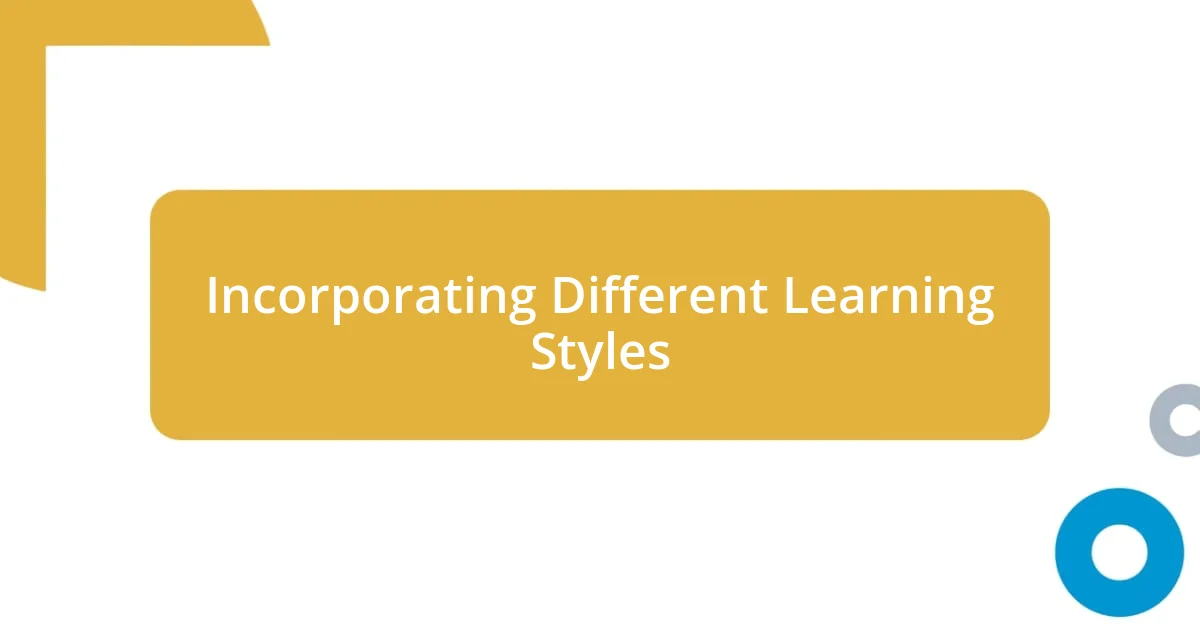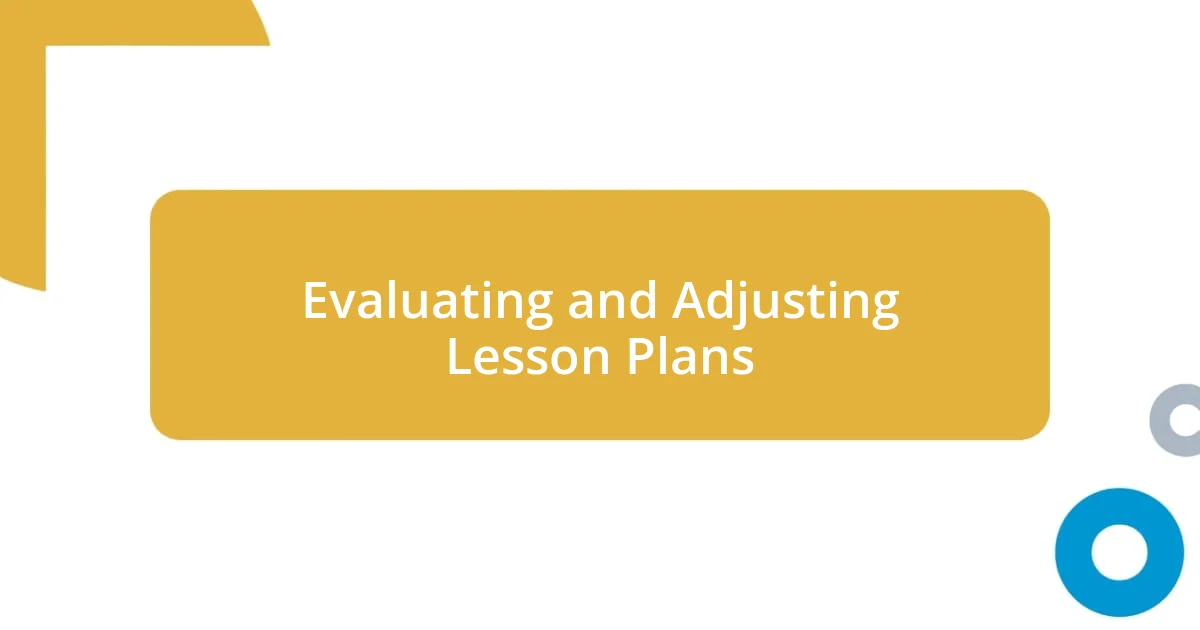Key takeaways:
- Clearly define learning objectives to guide lesson planning and activities.
- Incorporate diverse teaching methods and technology to enhance student engagement and cater to different learning styles.
- Continuously evaluate and adjust lesson plans based on student feedback and data analysis to improve understanding and confidence.

Planning Steps for Effective Lessons
When planning lessons, one of the most crucial first steps is to clearly define your learning objectives. I remember sitting down to create a lesson on fractions and thinking, “What do I actually want my students to walk away with?” That clarity set the stage for everything that followed, from the activities I chose to the assessments I designed.
Another step that’s always worked wonders for me is integrating diverse teaching methods. For instance, during a social studies lesson, I opted to use storytelling alongside visual aids. I noticed how my students’ eyes lit up as they connected with the material on a personal level. Have you ever seen how a well-told story can transform a dry topic into something unforgettable?
Finally, it’s essential to anticipate potential challenges that may arise during the lesson. I recall a time when a tech failure almost derailed a planned interactive activity. Instead of panicking, I smoothly adapted by switching to a hands-on approach. Reflecting on those moments, I realize that flexibility can often lead to discovering even richer learning experiences.

Strategies for Engaging Students
Engaging students requires more than just delivering content; it’s about creating an environment where they feel connected and invested. One tactic I’ve found effective is incorporating games into the lesson. For example, I once turned a grammar lesson into a competitive team game, and the excitement was palpable. I witnessed shy students, who usually hesitated to participate, stepping up and proudly sharing their answers. That energy transformed the classroom atmosphere and reinforced the lesson objectives.
Here are some strategies I’ve used to enhance student engagement:
- Incorporate Multimedia: Use videos or podcasts relevant to the lesson. This not only grabs attention but also caters to various learning styles.
- Group Work: Foster collaboration through small group activities. I’ve seen how students build off each other’s ideas, creating a richer understanding of the topic.
- Real-World Connections: Relate the lesson to real-life situations. During a math class, I shared a story about balancing a budget, which resonated with many students.
- Interactive Technology: Tools like interactive quizzes or polls can make learning fun and incorporate elements of choice that students love.
- Feedback Loops: регулярно solicit student feedback on what they enjoy or struggle with. This practice has allowed me to adjust my approach in real time, making lessons more tailored and effective.
The key is to be open to experimentation and to read the room. Sometimes, an unplanned discussion can spark the most profound learning moments.

Incorporating Different Learning Styles
When I first started incorporating different learning styles into my lesson plans, it was a game-changer. I vividly remember a science lesson on ecosystems where I grouped my students by their preferred learning styles. The hands-on learners created a terrarium, the visual learners made posters, while the auditory learners shared their findings through a group podcast. This variety not only catered to their individual strengths but also sparked collaboration among students who usually kept to themselves.
My experience has shown me that not addressing different learning styles can lead to students feeling overwhelmed or disconnected. For instance, during a mathematics unit, I noticed that some students were struggling with abstract concepts. By introducing manipulatives for the tactile learners and real-life scenarios for the logical thinkers, I saw their engagement increase dramatically. It was incredibly rewarding to witness those “aha” moments when students grasped complex ideas in a way that resonated with them personally.
Understanding that everyone learns differently is crucial in creating a supportive classroom environment. One memorable experience was during a language arts lesson, where I asked students to express their understanding of a novel through either a skit, a drawing, or a written reflection. The classroom buzzed with creativity, as each student eagerly showcased their unique approach. Their genuine excitement reminded me of the profound impact that respecting individual learning styles can have on building confidence and motivation.
| Learning Style | Activity Example |
|---|---|
| Visual Learners | Create posters or visual presentations |
| Auditory Learners | Engage in group discussions or podcasts |
| Tactile Learners | Use manipulatives for hands-on activities |

Using Technology in Lesson Planning
Integrating technology into lesson planning has revolutionized my teaching experience. For instance, during a history lesson on ancient civilizations, I used a virtual reality app that let students explore 3D reconstructions of historical sites. The awe on their faces as they ‘walked’ through ancient Rome made me realize how impactful immersive experiences can be. Doesn’t it amaze you how technology can transport students to different times and places, enhancing their learning in ways traditional methods sometimes can’t achieve?
I often rely on collaborative platforms like Google Classroom to facilitate group projects, allowing students to contribute at their own pace. One memorable project involved researching renewable energy sources. Students not only accessed information online but also used tools for real-time collaboration and feedback. It was inspiring to see how they took ownership of their learning process. Have you ever noticed how empowering it is for students to have immediate access to resources and the ability to communicate their ideas seamlessly?
I am a firm believer that technology can foster creativity in lesson planning. When I introduced a simple animation tool for science presentations, I watched shy students come alive, transforming their findings into engaging stories through visuals and sound. The excitement in the room was contagious! Isn’t it fascinating how giving students the right tools can unlock their creativity and boost their confidence? Leveraging these tech tools not only enhances understanding but creates a vibrant classroom dynamic that keeps students eager to learn.

Evaluating and Adjusting Lesson Plans
Evaluating and adjusting lesson plans is an essential part of my teaching journey. I remember after a particularly challenging week, I sat down to reflect on my math lessons. I realized that while my intentions were good, the pacing was off for several students who needed more time to grasp the concepts. This prompted me to rethink not only the lesson objectives but also the methods I was using to present the material.
One crucial strategy I’ve adopted is soliciting feedback from my students. After a writing unit, I asked them what parts of the lesson felt helpful and what felt confusing. Their insights were eye-opening. Some preferred interactive peer review sessions, while others thrived on structured guidance. I adjusted my future plans accordingly, and the improved engagement was evident. Isn’t it fascinating how students can be our best critics, often guiding us toward more effective teaching?
Data analysis plays a huge role in my evaluation process as well. After identifying trends in test scores, I often revise my lessons to address common misconceptions. For example, when I noticed a pattern in errors related to fractions, I developed additional hands-on activities and visual aids that specifically targeted those areas. The resulting improvement was not just in grades; students expressed a newfound confidence in tackling challenging material. It was a reminder of how adjusting our plans can lead to powerful transformations in student learning and engagement.

Reflecting on Lesson Planning Experience
Reflecting on my lesson planning experience often brings me back to those moments when everything just clicked. I remember one science lesson where I decided to incorporate real-world applications of physics concepts. Watching the students’ eyes light up as they connected the dots between theory and practice was incredibly fulfilling. Have you ever felt that rush when students grasp a concept you’ve tirelessly worked to convey?
Another insightful reflection comes from the times I’ve faced unexpected challenges. I once overestimated the time needed for a group activity, leading to rushed conclusions and frustrated students. That day taught me the importance of flexibility in lesson planning. I’ve learned to adapt on the spot, adjusting activities and expectations to better fit my students’ needs. It’s amazing how these teachable moments can reshape not just my lessons but my entire approach to teaching.
Lastly, I often think about the importance of personalizing lessons to cater to diverse learning styles. One year, I integrated storytelling into a literature lesson, and I saw quiet students flourish as they shared their interpretations. This experience reinforced my belief that every student brings something unique to the class, and finding ways to highlight those differences can create a richer learning environment. Don’t you agree that celebrating individuality can elevate the classroom experience for everyone involved?














